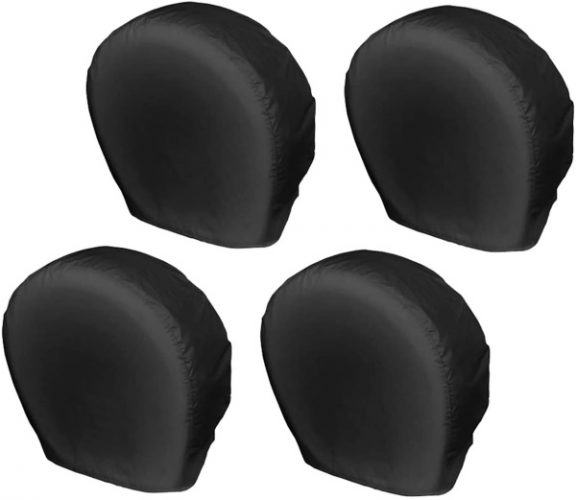Tires are crucial on an RV, and aside from the miles, sun, snow, and heat can all do damage to them when it’s parked. But, are RV tire covers worth it?
As a general rule, an RV that is parked for long periods outside will benefit from tire covers as they increase the lifespan of the tires, and protect the tires from the sun, rain, or snow, which can cause a lot of damage.
It is important to note though, that you will still need to maintain the tires even with RV tire covers.
In this article, we are not only going to discuss whether or not RV tire covers are worth it, but we are also going to discuss whether or not they are necessary.
We will then take a look at a few tips for maintaining your RV tires and a lot more. So, for everything you need to know, keep reading.

Are RV tire covers necessary?
RV tire covers are not absolutely necessary and many RV owners park their RVs without tire covers. However, they do extend the life of your tires.
So let’s take a quick look at why you should consider getting them:
- Tire covers protect the tires from rain
- Most importantly, they help prevent the tires from getting damaged by the sun
- Tire covers help prevent, but not eliminate, the chances of moisture getting into the tire and its components
- They help protect the wheel from rust
But if you’re living full-time in your RV and always on the road, they probably aren’t necessary as your vehicle is constantly in motion.
But let’s examine a couple of the most important benefits in greater detail.
Protect your tires from the sun
Unfortunately for tires, the sun is actually quite damaging.
One of the first things that can happen to your tires if exposed to the sun for too long is, they will start to crack. Once a tire cracks, it literally opens up the tire up to a whole host of other problems.
These cracks are often referred to as dry rot.
Eventually, a cracked tire will be much more prone to blowouts, flats, and will be more susceptible to punctures from nails or large rocks.
Prevent rust
Whether it is rain, snow, oxidization, or salt from being close to the sea, one of the biggest problems you can have with your RV wheels is rust. This is particularly around the rims and the axles.
When you cover your tires with a good RV tire cover, you limit the elements that can penetrate the tire and cause rust.
If you live on the coast, where saltwater damage is common, you have probably experienced rust in some capacity. And you should know that it is one of the last things that you want to happen anywhere on your RV, let alone just the tires.
Wash your RV tires regularly
Depending on where you live or where you currently live in your RV, different elements can affect your tire in different ways. The best thing for you to do is wash your tires regularly with a little soap that is safe for the tire.
When washing your RV, it is best to do the tires just before rinsing the RV. Use a soft brush and a soap/detergent that is safe to use on vehicles.
Once dry, especially if you don’t plan to use tire covers, use 303 Aerospace Protectant from Amazon to protect the tire. I have this at my house and it works great not only on tires but anything made from:
- Rubber
- Finished leather
- Plastic
- Vinyl
- PVC
- Fiberglass
CLICK HERE to see the current price on Amazon.
Covering the tires will protect the rubber and keep your RV durable for a long time #saladocreek #rvstorage https://t.co/fpVZ70jMIH pic.twitter.com/Vmu25VcgPE
— Jarrell RV Storage (@saladocreekrv) March 1, 2017
Do RV tire covers prevent dry rot?
RV tire covers provide the best protection against dry rot. They provide a significant amount of UV protection, increasing the lifespan and longevity of the RV tires.
Dry rot is when your tires start cracking on the outside.
It is mainly caused by the sun. It is important to remember that dry rot can lead to other severe issues with the RV tires.
And preventing this from happening will be preventing other issues.
Also, if you have noticed that your tires do have dry rot, I recommend that you have those tires replaced immediately because it is extremely unsafe to be driving on tires that are cracking.
Once your tires do start to crack from dry rot, the problem will only get worse.
And the severity will speed up as it gets worse. So, you want to protect yourself against this if you can. Tire covers can be one of the best defenses against this.
But if you don’t have tire covers, get the 303 Protectant on Amazon I mentioned in the above section. That is the 2nd best way to prevent dry rot.
@travelingrobert just got my new TT wish I could get a “Free in my RV” spare tire cover 🤔 pic.twitter.com/DJeZ8KYphK
— Levi (@levic1213) March 28, 2020
How to measure for RV tire covers
To measure an RV tire for covers use a measuring tape down the center of the tire and measure from side to side to the outside of the tread. Alternately, match the tire code on the tire to the code listed on the RV tire cover.
Every tire has its code on the tire wall.
You want to look for this code and write it down. Tire covers should indicate what specifications they are suited to and what they are made for.
But it’s not hard to measure if you can’t find the code.
As I mentioned at the top, with a measuring tape, simply go from side to side, across the center of the tire. Measure from the very outside of the tire tread to the outside of the tread on the other side.
If you cannot find the size of a cover for some crazy reason, the next thing for you to do would be to check the manual that came with the RV and see what the tire specifications are. You can probably also find that on the manufacturer’s website if it’s a newer RV.
RV spare tire cover. Decisions, decisions…….. pic.twitter.com/enRTzCx4ub
— Very Ape (@DapperKwitz) December 18, 2020
Do my RV tires have to be off the ground to put on tire covers?
Most RV tire covers do not require the tire to be lifted or removed in order to put the cover on. They are made in a way that they easily slip onto the tire simply while the RV is parked.
So luckily, since most of us won’t have a jack big enough for an RV, you don’t have to raise the tire up.
Most of the time, all you have to do is slip the tire cover over the top of the tire and pull it down so that it covers the entire tire.
Almost all RV tire covers have an elastic opening and some sort of locking mechanism to ensure the cover stays in place once on the tire.
Spare tire cover for the back of your RV. pic.twitter.com/ePWlLlZymI
— Brian Miles (@BrianPMiles) August 27, 2016
How do you maintain RV tires?
Maintaining your RV tires is about as important as having a good set of tire covers. Here is how to maintain your RV tires:
- Check the pressure of your RV tires every two weeks
- Do not exceed the PSI limit of your tires
- Have your RV tires checked regularly for balance and rotation
- Wash your tires regularly with safe chemicals
Now let’s examine those in greater detail.
Check your tire pressure
Constant driving AND constant sitting can cause air to slowly leak out of your tires.
Ironic, I know.
So it’s a good idea to check your tire pressure at least once or twice a month, especially if you have recently parked without moving it, or if you’ve been driving more than normal.
Luckily, there’s an easy way to do that and fill them up that doesn’t require you to go to the dealer or squeeze into the gas station by the air pump.
Just get one of these 2 handy RV tire air compressors on Amazon:
I have tried both, and with my Class A Newmar, I had better results with the 450p-RV. But my tires are 37″. Personally, I would get the 450 for any Class A or larger Class C, and the 400 for 5th Wheels, Class B, or Trailers.
Just click on either of those links to see the current price on Amazon.
Do not exceed the PSI limit
Most RV tires have a PSI (pounds per square inch) limit of anywhere from 80-110.
Generally, the larger the RV, the larger the tire. And that means a higher PSI number. The max PSI will be on the side of the tire, and while it’s likely going to be the same for all your tires, I like to check each tire before filling.
Have a professional check the balance and rotation of your tires
Tire rotation and balancing should take place every 6,000 to 8,000 miles.
Obviously, this is not a DIY job for most of us. It’s also not a job you can just pull into Discount Tire for as they ceased selling or working on tires over 16.5″ back in 2018.
So your best bet is either your dealer or the nearest RV service center.
RV held up nicely through the smokies. With a spare tire cover that read “Roughing it Smoothly” you can’t go wrong. pic.twitter.com/4Ime1qABuy
— Jason Jahnke (@JasonJahnke) August 14, 2016
What is the best color for RV tire covers?
The best color for RV tire covers is black, as they restrict more light and UV rays from getting to the tire. However, they do heat up faster than lighter colors, so lighter colors are better in areas prone to excess heat.
Remember, sunlight can lead to dry rot, which is one of the worst things to happen to your tires, as we discussed above.
Now, if you don’t mind having to wash your tire covers regularly to keep them visually appealing, you can simply get white covers. And if you live in Texas, as I do, or Arizona or someplace that gets beastly hot in summer, white probably is what you want.
But ultimately, this is about UV protection more than aesthetics.
And while any color of RV tire cover will block sunlight and UV rays, black just does it better, and is the best choice for most people.
Luckily, it’s not just black and white (pun intended).
You can usually get RV tire covers in black, white, gray, tan, and other colors. And we’re getting into my top picks for RV tires covers in the next section.
What do you think of this tire cover we bought for our #RV? #adventure #rvlife #digitalnomads #goRVing pic.twitter.com/xNugTW1JKD
— Hannah Sutor (@hhsutor) June 28, 2018
What are the best RV tire covers?
Here are the best RV tire covers in different size categories:
Best RV Tire Covers for Larger Class C and Class A RVs
I like Moonet Tire Covers for larger RV tires, although they do offer smaller sizes too. 
Moonet has really outdone themselves with their four-pack of RV tire covers. As we discussed in the article, black is the best color, so they are spot on with that. We also couldn’t believe the price of these tire covers.
You can pay anywhere from $18 to $26 for a pack of four, which is really good.
And while I know many larger RVs do have 6 tires, unless your rear axel tires are side by side, you only need 4 since you can’t get to those interior tires.
They have a wide range of options for you to choose from, ranging anywhere from 24 inches all the way up to 42 inches. So, once you know the diameter of your tires, they should have something for you.
They use an Oxford waterproof material that is resilient and will do a great job of blocking out not only the sun but most other harmful elements.
CLICK HERE to see them on Amazon
Best RV Tire Covers for Class C, B, Trailers & 5th Wheel RVs
For smaller tires, I prefer Explore Land Store Tough Tire Wheel Protectors. 
They have more color options, and while these are not the cheapest out of the two, their price is most definitely worth it, and still currently under $50 bucks for a set of 4.
They have a variety of sizes that can fit anything from 23 inches to 34.75 inches.
They also have a selection of colors that you can choose from.
But I still recommend sticking with black, unless you live somewhere that gets super hot in summertime.
The covers themselves are treated with an anti UV treatment that makes these covers one of the more resilient covers to sunlight.
All of this while still being able to protect your tires against things like rain, snow, dirt, and rust.
CLICK HERE to see them on Amazon
Should you cover RV tires in winter?
RV tires are damaged both by excess sun, but also in the harsh winter conditions in certain climates.
So if you live somewhere that gets a lot of snow and ice, I would definitely consider putting tire covers on when the winter season is approaching.
Plus remember. Even in winter, the sun can still do a lot of damage to your RV’s tires too.
Winter is here and if you have a RV these ride covers are exactly what you need! These are well made of strong material and secure to your tires. Check them out below! https://t.co/6EpLUljwfa#rvtirecover pic.twitter.com/HgOdojybYX
— RockieMountainLife (@JmccordinDenver) January 4, 2018
What are RV tire covers made of?
Most RV tire covers are made from high-quality vinyl. They usually have a water-resistant and UV-resistant coating on them and the seams are typically double-stiched. An elastic cord allows the cover to be pulled tight once in place.
What should I look for in an RV wheel cover?
Look for one with good reviews (obviously, like the ones I link to above). It should be thick material, double-stiched, and offer protection from both water and UV rays.
A black or dark gray color will stop more UV rays from damaging the tires. However, they do emit more heat to the tire in super-hot weather.
So if you live somewhere extra hot (like Texas or Arizona), a lighter color may be better for summertime.
Conclusion
Tires might just seem like lumps of rubber that are designed to take a beating on the open road.
While this is true, they still need to be looked after. Tire covers may be a small inconvenience, however, they are a small price to pay to protect something that, if not looked after, can cost a lot of money.
And again, if you opt to not get tire covers, get the 303 Protectant on Amazon I mentioned in the above sections. That is the 2nd best way to prevent dry rot and extend the life of your tires.
Middle Class Dad is a participant in the Amazon Services LLC Associates Program, an affiliate advertising program designed to provide a means for sites to earn advertising fees by advertising and linking to Amazon.com. As an Amazon Associate, I may earn a small commission from qualifying purchases if you click to Amazon from my site and choose to make a purchase. This is no way increases the cost to you.
